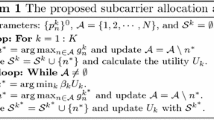Abstract
Efficiency and fairness are two crucial issues to be considered for resource allocation in multi-user wireless networks. Based on the joint optimization of physical layer and data link layer, an optimization model is derived to achieve efficient and fair downlink data scheduling in multi-user OFDM wireless networks by maximizing the total utility function with respect to the average waiting time of user queue. A dynamic sub-carrier allocation algorithm (DSAA) based on the optimization model is proposed in order to obtain the maximization of the total scheduling utility. Efficiency is improved by combining DSAA with time scale interference predictor (TSIP) which at large time scales predict ON/OFF period of user data with temporal correlation structure across multiple time scales in multi-user interference environment. Simulation results verify the efficiency and fairness of the scheme.
Similar content being viewed by others
References
Lu S W, Vaduvur B, Srikant R. Fair scheduling in wireless packet network. IEEE/ACM Trans Network, 1999, 7: 473–489
Eugene N T S, Stoica I, Hui Z. Packet fair queuing algorithms for wireless networks. IEEE INFOCOM 1998, 1: 1103–1111
Cao Y, Li VOK. Scheduling algorithms in broad-band wireless networks. Proc IEEE ICC, 2001, 89: 76–87
Viswanath P, Tse D N C, Laroia R. Opportunistic beamforming using dumb antenna. IEEE Trans Inform Theory, 2002, 48: 1277–1294
Borst S. User-level performance of channel-aware scheduling algorithms in wireless data networks. IEEE INFOCOM, 2001, 321–331
Andrews M, Krishnan K, Kavita R, et al. Providing quality of service over a shared wireless link. IEEE Commun Mag, 2001, 1.39: 15–154
Bender P, Black P, Grob M. CDMA/HDR: A bandwidth efficient high-speed wireless data service for nomadic users. IEEE Commun Mag, 2000, 38: 70–77
Jalali A, Padovani R, Pankaj R. Data throughput of CDMA HDR a high efficiency-high data rate personal communication wireless system. Proc 50th IEEE Veh, 2004, 3: 1854–1858
Li C Z, Papavassiliou S. Fair channel-adaptive rate scheduling in wireless networks with multirate multimedia services. IEEE J Selected Areas in Commun, 2003, 21(10): 1604–1614
Jiang Z, Ge Y, Li Y G. Max-utility wireless resource management for best effort traffic. IEEE Trans Wireless Commun, 2005, 4(1): 100–111
Xiao M, Shroff N B, Chong E K P. Utility-based power control in cellular wireless systems. In: Proceedings of the Annual Joint Conference of the IEEE Computer and Communications Societies (INFOCOM). Alaska, USA, 2001. 412–421
Song G, Li Y G. Cross-layer optimization for OFDM wireless network — part I and part II. IEEE Trans Wireless Commun, 2005, 4(2): 614–634
Song G, Li Y G. Adaptive resource allocation based on utility optimization in OFDM. IEEE Global COM, 2003, 2: 586–590
Crovella M E, Bestavros A. Self-similarity in world wide web traffic: Evidence and possible causes. IEEE/ACM Trans Network, 1997, 5: 835–846
Assmussen S. Applied Probability and Queues. 2nd ed. New York: Springer, 2002
Russell S, Norvig P. Artificial Intelligence: A Modern Approach. 2nd ed. Princeton, NJ: Pretice Univ Press, 2003
Kruse R L, Ryba A J. Data Structures and Algorithm Design in C++. England Clidds, NJ: Prentice-Hall, 2nd ed, Princeton, NJ: Prentice Univ Press, 1999
Willinger W, Paxson V, Taqqu M S. Self-similarity and Heavy Tails: Structural Modeling of Network Traddic. 2nd. Princeton, NJ: Prentice Univ Press, 1998. 27–53
Rockafellar R T. Convex Analysis. Princeton, NJ: Princeton Univ Press, 1970
Author information
Authors and Affiliations
Corresponding author
Additional information
Supported by the Research on Wireless Broadband Access System and Application Demonstration (Grant No. 05dzl 5008)
Rights and permissions
About this article
Cite this article
Guo, K., Sun, L., Wang, P. et al. Efficiency-aware and fairness-aware joint-layer optimization for downlink data scheduling in OFDM. Sci. China Ser. F-Inf. Sci. 51, 171–182 (2008). https://doi.org/10.1007/s11432-008-0009-1
Received:
Accepted:
Issue Date:
DOI: https://doi.org/10.1007/s11432-008-0009-1




